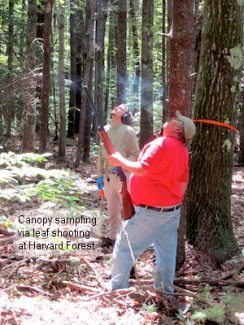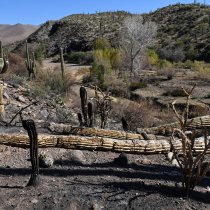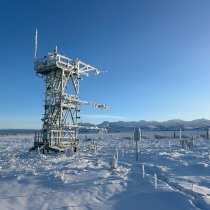Samples, Shoots and Leaves at Harvard Forest
October 31, 2012

Canopy sampling at Harvard Forest
terrestrial ecologists and the Airborne Observation Platform (AOP). The combined ground- and airborne-based efforts will create one of NEON’s first combined datasets. This dataset will allow scientists on both teams to address issues related to the airborne and ground components separately, and to work on integrating the data streams. In 2010, NEON collaborated with AVIRIS and NCALM to conduct a similar ground- and air-based prototype at the Domain 3 core site at Ordway-Swisher Biological Station. As a child of the temperate zone, I was thrilled to get back to Harvard Forest. In fact, this Long-term Ecological Research site hosts the forested systems in which I played hide-and-seek in as a kid, and first learned to measure soil respiration (microbes breathing!) as a college student. It seemed logical that I go there to take my first step into piecing together how to do extensive, long-term research. But let me get back to the part about shooting leaves. Unless you are a terrestrial ecologist already familiar with this standard approach to reaching the very top of the plant canopy, the mention of shooting at leaves might make your eyes light up. The reality of canopy shooting, however, turns out to be less of a simple, pleasurable pastime than one might think. Our goal in this prototype effort was to evaluate relationships between soil, plant, and microbial biogeochemistry

“see” the trees. Our effort amounted to 400 lead-free pellets shot straight into the air, one bruised shoulder, and 216 samples caught by the very nimble Dr. Benjamin Chemel, a NEON contractor who oversaw the ground-based collection. The canopy leaves, as well as the soil samples collected from the forest floor below them, have been shipped off to laboratories for analysis of carbon and nitrogen elemental content and isotopes. In addition, we will analyze the mRNA of soil microbial populations. These data, which will eventually be available to the larger community, will be used to explore approaches for calculating plant and soil nutrient stocks and to evaluate the likelihood that genetic information from microbes will help us infer dominant soil biogeochemical processes, such as the occurrence of denitrification (changing inorganic soil nitrogen to gaseous nitrogen). Broadly, they will help us to refine the overall research design for Domain 1 and beyond. Canopy shooting at Harvard Forest may have been relatively easy (well, maybe not for Scot, although he made it look easy). We'll be collecting leaves this way at any site where we have tall trees that cannot be sampled by hand or by pole pruner. But how will we sample plant canopy leaves in places where we cannot clip by hand or shoot with a shotgun? NEON sites include areas within national parks and regions like the Pacific Northwest where trees are much, much taller than in the Northeastern U.S. Perhaps NEON will adopt and train the first group of scientifically-minded orangutans. Stay tuned!

